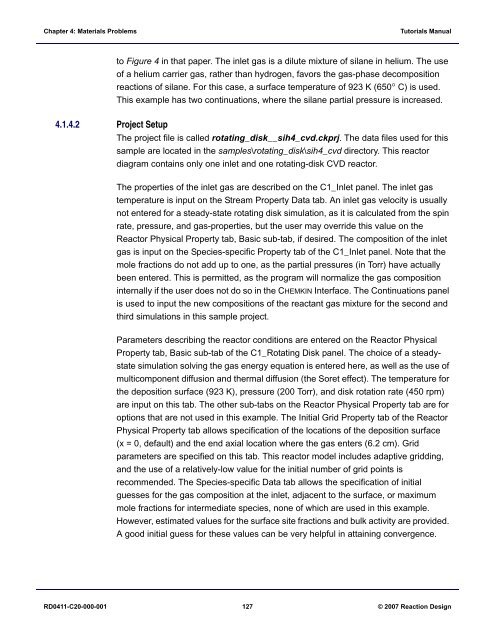Tutorials Manual
Tutorials Manual
Tutorials Manual
Create successful ePaper yourself
Turn your PDF publications into a flip-book with our unique Google optimized e-Paper software.
Chapter 4: Materials Problems<br />
<strong>Tutorials</strong> <strong>Manual</strong><br />
to Figure 4 in that paper. The inlet gas is a dilute mixture of silane in helium. The use<br />
of a helium carrier gas, rather than hydrogen, favors the gas-phase decomposition<br />
reactions of silane. For this case, a surface temperature of 923 K (650° C) is used.<br />
This example has two continuations, where the silane partial pressure is increased.<br />
4.1.4.2 Project Setup<br />
The project file is called rotating_disk__sih4_cvd.ckprj. The data files used for this<br />
sample are located in the samples\rotating_disk\sih4_cvd directory. This reactor<br />
diagram contains only one inlet and one rotating-disk CVD reactor.<br />
The properties of the inlet gas are described on the C1_Inlet panel. The inlet gas<br />
temperature is input on the Stream Property Data tab. An inlet gas velocity is usually<br />
not entered for a steady-state rotating disk simulation, as it is calculated from the spin<br />
rate, pressure, and gas-properties, but the user may override this value on the<br />
Reactor Physical Property tab, Basic sub-tab, if desired. The composition of the inlet<br />
gas is input on the Species-specific Property tab of the C1_Inlet panel. Note that the<br />
mole fractions do not add up to one, as the partial pressures (in Torr) have actually<br />
been entered. This is permitted, as the program will normalize the gas composition<br />
internally if the user does not do so in the CHEMKIN Interface. The Continuations panel<br />
is used to input the new compositions of the reactant gas mixture for the second and<br />
third simulations in this sample project.<br />
Parameters describing the reactor conditions are entered on the Reactor Physical<br />
Property tab, Basic sub-tab of the C1_Rotating Disk panel. The choice of a steadystate<br />
simulation solving the gas energy equation is entered here, as well as the use of<br />
multicomponent diffusion and thermal diffusion (the Soret effect). The temperature for<br />
the deposition surface (923 K), pressure (200 Torr), and disk rotation rate (450 rpm)<br />
are input on this tab. The other sub-tabs on the Reactor Physical Property tab are for<br />
options that are not used in this example. The Initial Grid Property tab of the Reactor<br />
Physical Property tab allows specification of the locations of the deposition surface<br />
(x = 0, default) and the end axial location where the gas enters (6.2 cm). Grid<br />
parameters are specified on this tab. This reactor model includes adaptive gridding,<br />
and the use of a relatively-low value for the initial number of grid points is<br />
recommended. The Species-specific Data tab allows the specification of initial<br />
guesses for the gas composition at the inlet, adjacent to the surface, or maximum<br />
mole fractions for intermediate species, none of which are used in this example.<br />
However, estimated values for the surface site fractions and bulk activity are provided.<br />
A good initial guess for these values can be very helpful in attaining convergence.<br />
RD0411-C20-000-001 127 © 2007 Reaction Design
















